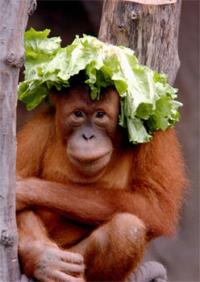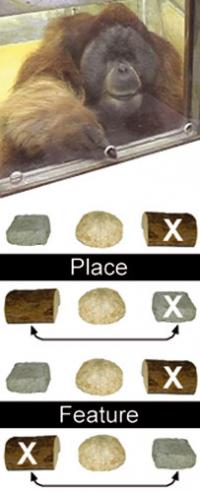
Padana, a young female orangutan at the Leipzig Zoo, who was one of the research subjects. How did our evolutionary ancestors make sense of their world? What strategies did they use, for example, to find food? Fossils do not preserve thoughts, so we have so far been unable to glean any insights into the cognitive structure of our ancestors. However, in a study recently published in Current Biology (September 5, 2006), researchers at the Max Planck Institute for Psycholinguistics and their colleagues at the Max Planck Institute for Evolutionary Anthropology were able to find answers to these questions using an alternative research method: comparative psychological research. In this way, they discovered that some of the strategies shaped by evolution are evidently masked very early on by the cognitive development process unique to humans.
Being able to remember and relocate particular places where there is food is an asset to any species. There are two basic strategies for remembering the location of something: either remembering the features of the item (it was a tree, a stone, etc.), or knowing the spatial placement (left, right, middle, etc.). All animal species tested so far - from goldfish, pigeons and rats though to humans - seem to employ both strategies. However, if the type of recall task is designed so that the two strategies are in opposition, then some species (e.g. fish, rats and dogs) have a preference for locational strategies, while others (e.g. toads, chickens and children) favor those which use distinctive features.
Test conditions: A mature male orangutan carries out the tasks.
Until now, no studies had systematically investigated these preferences along the phylogenetic tree. Recently, however, Daniel Haun and his colleagues have carried out the first research of its kind into the cognitive preferences of a whole biological family, the hominids. They compared the five species of great apes - orangutans, gorillas, bonobos, chimpanzees and humans - to establish which cognitive strategies they prefer in order to uncover hidden characteristics. The researchers worked on the assumption that if all five species share particular preferences, these are very probably a part of the evolutionary legacy of our most recent common ancestors, who died out some 15 million years ago.
At the Wolfgang Koehler Primate Research Center at the Leipzig Zoo, the researchers hid coveted items using two different strategies (see Fig.2): In the place condition, the item remained in the same place it was hidden in previously, but under a different object (e.g. a stone); in the feature condition the object remained the same, but the place changed. It was established that all four great ape species and one-year-old children actually use the location as a way of finding something hidden, even if it is hidden under a completely different object. This outcome suggests that this preference has been part of our cognitive structure for 15 million years.
The researchers then investigated three-year-old children and discovered a difference: Unlike younger children, they considered the object under which the item was hidden to be the most reliable indication of its whereabouts, even if the location had changed completely. The scientists have sufficient evidence to conclude that 1-year-old children and great apes do not lack the capability to develop a feature-based strategy, but simply prefer to use a place-based strategy. Evidently, humans reassess these preferences as their cognitive development continues.
"The unique human cognitive development seems to mask some of our evolved strategies even before we reach the age of three," says Daniel Haun. "In future experiments, we therefore want to find out which areas of cognitive development in humans, for example language acquisition, are responsible for this restructuring of cognitive preferences." The new methodical approach and the results it yields pave the way for the systematic study of the cognitive structures of our evolutionary ancestors and thus ultimately to an improved understanding of the origins of human thinking. Source : Max-Planck-Gesellschaft
 Print Article
Print Article Mail to a Friend
Mail to a Friend
